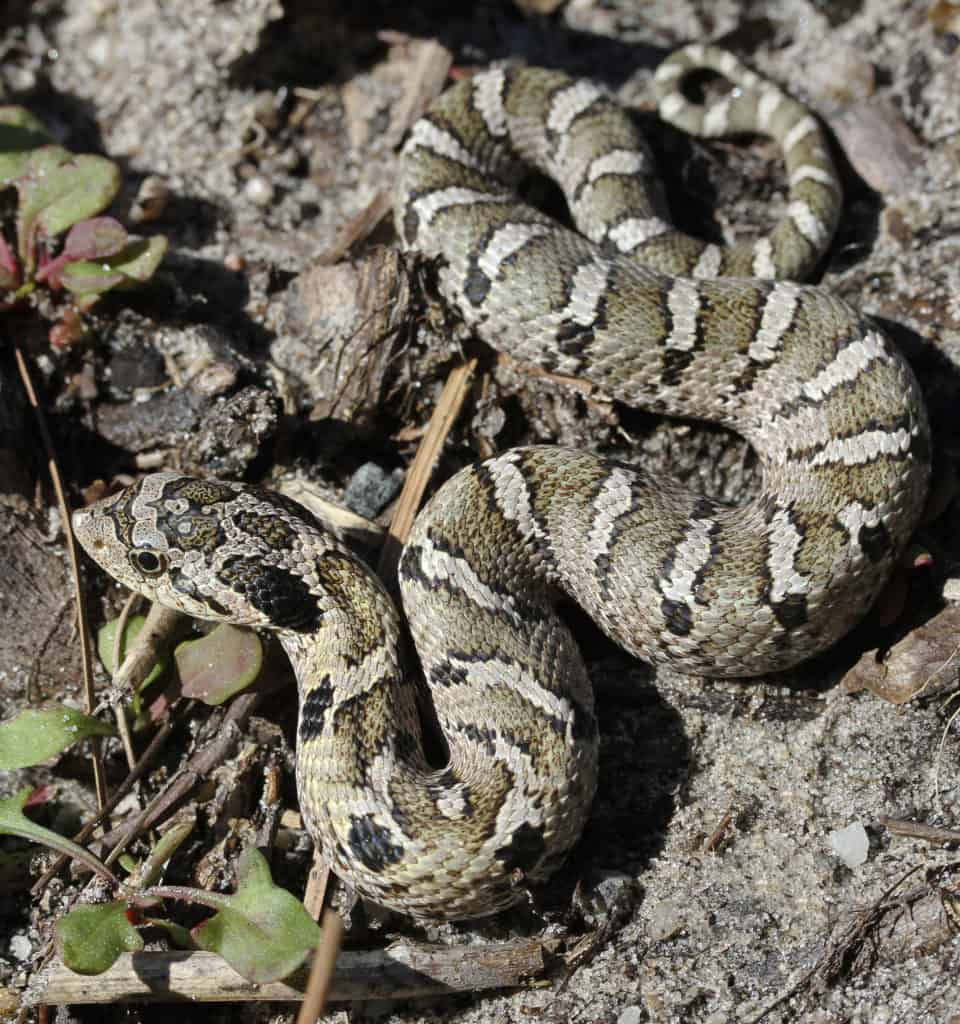Creature Feature

Master Imitator: The Eastern Hognose Snake
By Wayne Bierbaum
On a cool late summer morning, I was walking with my wife around the large waterfowl pond at Chincoteague National Wildlife Refuge in Virginia. After rounding the far side of the pond, there was a spot in the sun and protected from the cool breeze. Immediately it was apparent that this is where the animals were congregated. Birds, lizards, and snakes were easy to find.
For me the most interesting animal was a small well-camouflaged snake. It had a turned-up nose and nervous tail which it rattled in the rocks. The snake was an eastern hognose snake.
The hognose snake is known by multiple names and has a lot of folk lore associated with it. A list of alternate names cited by the Virginia Herpetology Society are: Adder, bastard rattlesnake, black adder, black blowing viper, black hog-nosed snake, black viper snake, blauser, blower, blowing adder, blowing snake, blowing viper, buckwheat-nose snake, calico snake, checkered adder, chuck head, common spreading adder, deaf adder, flat-head, flat-headed adder, hissing snake, hissing viper, mountain moccasin, poison viper, puff adder, red snake, rock adder, sand adder, sand viper, spotted viper, spread-head moccasin, spread-head snake, spread-head viper.
These snakes have such a wide assortment of names and a false reputation as being dangerous is due to the way they try to bluff predators. When danger approaches, the first thing they do is freeze to let their camo work. If the camouflage doesn’t work then the snake will likely perform a rattlesnake imitation by rapidly shaking its tail. If that fails then it starts a puff adder imitation, where their body and jaws flatten, they hiss loudly and do a floppy strike. It looks dangerous but in reality, they almost never ever bite.
If the puff adder performance does not scare the danger away, the snake will go into death throes. It will slowly writhe and twist onto its back and then go limp. The snake adds to the drama by hanging its tongue out, letting its open jaw go slack, and visibly slowing its breathing. If the snake is turned to its stomach, it will turn back over. If it is picked up in this fake death stage, the hognose snake will maintain a limp body. House cats in particular tend to ignore a dead looking snake.
The hognose snake is fairly common, with sub-species spread throughout the United States. In Maryland, only the eastern subspecies is present but it comes in a variety of colors and patterns. They can be almost all-black, gray-checked or patterned in red and black. Unfortunately, they can resemble poisonous snakes—black hognose snakes look like water moccasins, the gray ones look like rattlesnakes and the reddish ones can resemble a timber rattler or a copperhead. They are often killed by people at first sight.
They are medium-sized thick-bodied snakes at most about three feet long. Hognose snakes have a varied diet of mostly insects and frogs, with a predilection for toads. The snakes have rear fangs and a mild poison used to stun prey. Despite the poison, they are known to be very calm, rarely bite and make good pets.
Wild snake collecting, especially with certain western sub-species, has caused some local extinctions. Maryland requires a special permit to collect or possess wild snakes. If you are interested, hognose snakes will breed in captivity and those off-spring can be obtained through legal dealers.
If you cannot tell if the snake you see is a hognose or a rattler, a rule for poisonous snake identification in Maryland is that non-poisonous snakes have round pupils and poisonous ones have vertical pupils.
